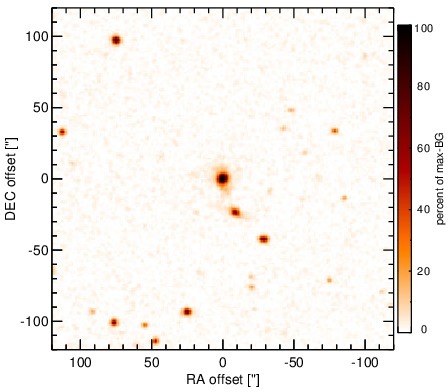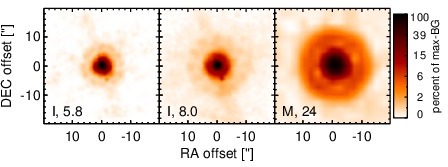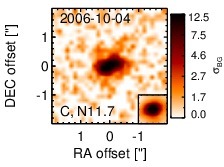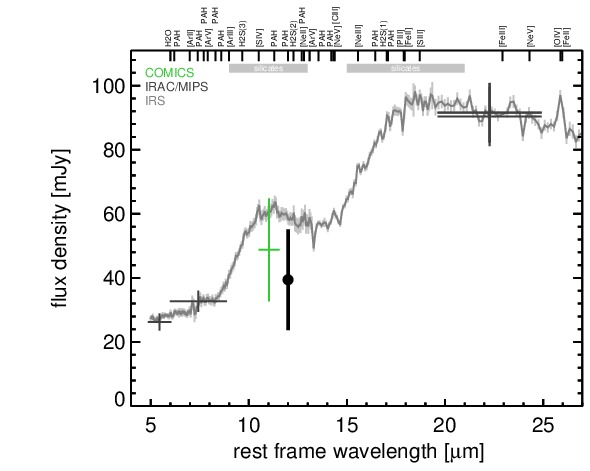Sasmirala Individual Information for PG 0844+349
Description
PG 0844+349 is a radio-quiet quasar at a redshift of z = 0.0640 (D~ 302 Mpc) with an optical Sy 1.0 classification [veron-cetty_catalogue_2010] in an interacting barred spiral host galaxy [hutchings_images_1990]. Its properties are quite similar to a narrow-line Sy 1 type AGN[brinkmann_xmm-newton_2003]. At radio wavelengths, the nucleus is unresolved [kellermann_radio_1994]. PG 0844+349 was first detected in the MIR with IRAS [neugebauer_quasars_1986], and followed up with the Palomar Observatory [neugebauer_continuum_1987, neugebauer_variability_1999] and Spitzer/IRAC, IRS and MIPS. The corresponding IRAC and MIPS images show a compact nucleus without significant host emission. The IRS LR staring-mode spectrum exhibits prominent silicate 10 and 18 μm emission, a very weak PAH 11.3 μm feature, and a shallow blue spectral slope in νFν-space (see also [shi_aromatic_2007]). PG 0844+349 was imaged with COMICS in the N11.7 filter in 2006 [imanishi_subaru_2011], and an elongated nucleus was detected (FWHM(major axis)~ 0.75arcsec ~ 1 kpc; PA~ 108∘). However, at least a second epoch of subarcsecond MIR imaging is required to verify this extension. Our nuclear N11.7 photometry is consistent with the value by [imanishi_subaru_2011] and the Spitzer spectrophotometry. Therefore, we use the latter to compute the nuclear 12 μm continuum emission estimate corrected for the silicate feature. Note however, that the nuclear flux would be significantly lower if the subarcsecond-extended emission can be verified. For now, the resulting synthetic flux is then scaled by half of the ratio between FνPSF and FνGau to account for the possibly nuclear extension.
- [brinkmann_xmm-newton_2003] W. Brinkmann, D. Grupe, G. Branduardi-Raymont, and E. Ferrero. XMM-Newton observation of PG 0844+349 . A&A , 398 pp. 81–87, January 2003.
- [hutchings_images_1990] J. B. Hutchings and D. Crampton. Images and off-nuclear spectroscopy of QSOs . AJ , 99 pp. 37–44, January 1990.
- [imanishi_subaru_2011] Masatoshi Imanishi, Keisuke Imase, Nagisa Oi, and Kohei Ichikawa. Subaru and gemini high spatial resolution infrared 18 μm imaging observations of nearby luminous infrared galaxies . AJ , 141 pp. 156, May 2011.
- [kellermann_radio_1994] K. I. Kellermann, R. A. Sramek, M. Schmidt, R. F. Green, and D. B. Shaffer. The radio structure of radio loud and radio quiet quasars in the palomar bright quasar survey . AJ , 108 pp. 1163–1177, October 1994.
- [neugebauer_continuum_1987] G. Neugebauer, R. F. Green, K. Matthews, M. Schmidt, B. T. Soifer, and J. Bennett. Continuum energy distributions of quasars in the palomar-green survey . ApJS , 63 pp. 615–644, March 1987.
- [neugebauer_quasars_1986] G. Neugebauer, G. K. Miley, B. T. Soifer, and P. E. Clegg. Quasars measured by the infrared astronomical satellite . ApJ , 308 pp. 815–828, September 1986.
- [neugebauer_variability_1999] G. Neugebauer and K. Matthews. Variability of quasars at 10 microns . AJ , 118 pp. 35–45, July 1999.
- [shi_aromatic_2007] Yong Shi, Patrick Ogle, George H. Rieke, Robert Antonucci, Dean C. Hines, Paul S. Smith, Frank J. Low, Jeroen Bouwman, and Christopher Willmer. Aromatic features in AGNs: star-forming infrared luminosity function of AGN host galaxies . ApJ , 669 pp. 841–861, November 2007.
- [veron-cetty_catalogue_2010] M.-P. Véron-Cetty and P. Véron. A catalogue of quasars and active nuclei: 13th edition . A&A , 518 pp. 10, July 2010.
Images

Optical image (DSS, red filter). Displayed are the central 4 arcmin with North being up and East to the left. The colour scaling is linear with white corresponding to the median background (BG) and black to the 0.01% pixels with the highest intensity.

Spitzer MIR images. Displayed are the inner 40 arcsec with North being up and East to the left. The colour scaling is logarithmic with white corresponding to median BG and black to the 0.1% pixels with the highest intensity. The label in the bottom left states instrument and central wavelength of the filter in micron (I: IRAC, M: MIPS).

Subarcsecond-resolution MIR images sorted by increasing filter central wavelength. Displayed are the inner 4 arcsec with North being up and East to the left. The colour scaling is logarithmic with white corresponding to median BG and black to the 75% of the highest intensity of all images in units of sig_bg. The inset image (where present; either bottom or top right) shows the central arcsecond of the PSF from the calibrator star, scaled to match the science target. The labels in the bottom left state instrument and filter names (C: COMICS, M: Michelle, T: T-ReCS, V: VISIR).
SEDs


MIR SED. The description of the symbols in all the SED plots (where present) is the following: Grey crosses and solid lines mark the Spitzer/IRAC, MIPS and IRS data. The colour coding of the other symbols is as follows: green for COMICS, magenta for Michelle, blue for T-ReCS and red for VISIR data. Darker-coloured solid lines mark spectra of the corresponding instrument. The black filled circles mark the nuclear 12 and 18 micron continuum emission estimate from the data (where present). The ticks on the top axis mark positions of common MIR emission lines, while the light grey horizontal bars mark wavelength ranges affected by the silicate 10 and 18 micron features.